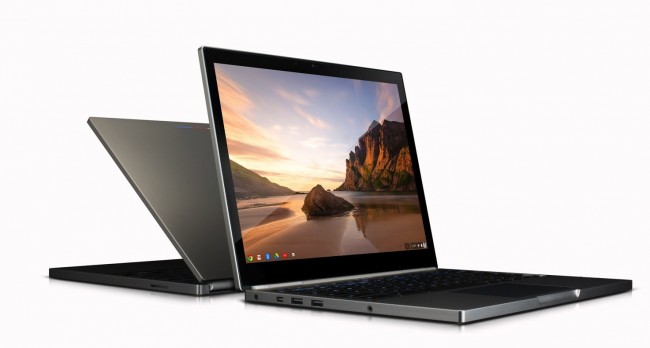It’s been nearly two years since the launch of the first ChromeOS laptop. With each new release, the platform is showing its mettle with a small, but growing number of disaffected Windows consumers.
No ad to show here.
First it was the low price. Then it was the aspect of working in the cloud. Or maybe it’s that ultra fast (seven second) start-up. In any case, today’s tech manufacturers are coming up with new models of Google Chromebooks faster and faster — and buyers will benefit. Using Web tools offered by Google and other apps, these new Chromebooks from producers like Acer, HP, Samsung and likely more to come provide the most complete, proficient workspace to date for laptop users.
1. Price Price Price: C’mon, the only reason you want a Chromebook is for the under US$300 price for most models.
2. Sync capabilities: Chrome OS syncs up with your Google account, so you have direct access to all Google Chrome browser bookmarks, extensions, and applications instantly upon setting up your Chromebook. These laptops download and install software updates automatically.
3. Fast start-up and Instant Resume: The 16GB solid state drives that are in most Chromebooks are super quick and let you start and stop your work as needed, prior to meetings, eating and other life’s distractions.
4. The always-on web connections: Wired writes: “Without a web connection, a Chromebook can’t do much more than view files you have stashed in your 16GB of storage. You do have the ability to perform off-line edits of any Google Docs you’ve had the foresight to sync to your Chromebook.
5. Touchscreen interactivity: Google’s taken a stab at the premium market with the Pixel. The US$1 300 laptop comes with a 12.85-inch display, a 2560×1700 touchscreen, an i5 CPU and a free terabyte of cloud storage for three years, care of Google Drive. It’s pricey sure, but pretty damn ambitious too.
6. Great deal for students: Google has been marketing young users and college students who already work in the (Google) cloud of online services. TechCrunch reported that Google is targeting the Chromebooks to schools and college students as options to more expensive MS Windows-based laptops. Having one would be a big advantage for any students attending accredited online colleges.
7. Light and shiny: Who wouldn’t want an ultra-fast, light and shiny laptop in their backpack to whip out at a moment’s Wi-Fi notice?
Detractors might ask “What’s the benefit in running everything under just one main application?” But if you’re already deep into working under Google’s services umbrella (Gmail, Drive, Wallet, Google Play, Google+, etc), owning and using a Chromebook isn’t a disadvantage, it’s a breakthrough! Plus, since Chrome OS runs Web applications from the cloud, instead of applications downloaded internally to the Chromebook itself, it’s unlikely your Chromebook will ever deal with virus, malware or spyware infections.
Chrome OS also allows you to use valuable add-ons that will increase the functionality of Chrome. The Last App, for example, serves as a password manager that automatically logs users onto various websites, and syncs passwords across other devices. The Pocket App is another great extension that lets you save Web pages you want to read later, or share them across devices. And, in addition, there are a few apps already built into Chrome OS, like the Files Manager App. This handy app lets users upload multiple files that can be transferred to your hosting account with a single upload. A media player app also comes pre-installed, letting you watch videos or listen to audio with or without an Internet connection.
Samsung Chromebook
The specs of the Samsung Chromebook Series 3 look are terrific, along with the price, which falls below $250 and includes:
- 1.7 Ghz Exynos ARM-based processor
- integrated graphics
- 2GB of DDR3L RAM
- 11.6″ 1366 x 768 pixel resolution LED-lit matte screen
- 16GB of eMMC storage
- 802.11a/b/g/n wireless networking
- 3G connectivity
- SD card reader
- 0.3MP webcam
The sleek and ultra-portable Chromebook has a full-sized keyboard and trackpad and an 11.6-inch matte display with a 1366 x 768 resolution, versus the 12.1-inch, 1280 x 800 display found on the Series 5 Chromebook. Overall, the Chromebook looks, runs, and feels like Apple’s Macbook Air—but at a quarter of the price.
Acer Chromebook
Another viable Chromebook option is the Acer C7 Chromebook model. Priced at $299, the model looks very similar to Acer’s $199 model. But under the hood, the new model boasts a 1.1 GHz Celeron processor, and has doubled the RAM to 4GB from the lower-priced model. Acer also doubled the size of its removable battery, resulting in up to 6 hours of run-time battery life on a single charge. Lastly, the former 320GB hard drive has been switched out for an expanded 500GB drive.
HP Chromebook
The second newest entry to the Chromebook manufacturers is HP, which released its HP Pavilion Chromebook model at the start of 2013. Specs include:
- 14’’ BrightView LED-backlit display (1366 x 768)
- 0.83 inch thin – 3.96 lbs / 1.8 kg
- Up to 4.25 hours of battery
- Dual-core Intel Celeron Processor
- 100 GB Google Drive Cloud Storage with 16GB Solid State Drive
- Built-in dual band Wi-Fi 802.11 a/b/g/n and ethernet
- HD Camera, 3x USB 2.0, HDMI Port
- 2-in-1 memory card slot (SD, MMC)
- Bluetooth 3.0 Compatible
- Kensington key lock compatible
WebPro News writes: “Compared to the other Chromebooks from Acer and Samsung, HP’s Pavilion 14 is probably the second best available. The downside to that is the increased cost. It’s not as ludicrous as Samsung’s Chromebook 550, which retails for $450, but $330 may still be a bit too much for those looking for something super cheap like Acer’s $199 Chromebook.”
So that’s Chromebook! Great for Googlers, fine for many others, and interesting to millions. Will there be a touchscreen Chromebook in 2013? Only time will tell.
